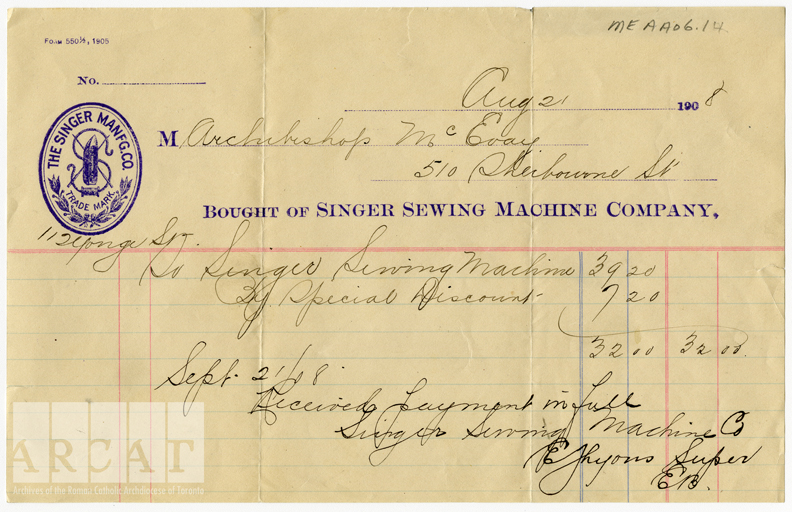These documents give us an amazing glimpse into the past by showing us what people were purchasing, what they were eating, and what they were wearing. They show us where people were shopping, the types of businesses that existed in the city, and how much things cost. They help us fill in the picture of what everyday life was like for those whose actions created our modern world.
 |
| This 1908 Bell bill shows that Archbishop McEvay paid $1.05 for calls to Hamilton, Guelph and Niagara Falls in the month of August. Archbishop McEvay Fonds: ME AA06.12 |
 |
| In 1908 you could buy a rug and a mattress for $9.25 from The J. F. Brown Company. The J.F. Brown site is now a heritage building at 193 Yonge St., across from the Eaton Centre. Archbishop McEvay Fonds: ME AA06.31 |
 |
| $35.50 for carriage repairs at The Enright Shoeing Forge in December, 1909. Very important to maintain your means of transportation! Archbishop McEvay Fonds ME AA06.78 |
 |
| $4.00 for office supplies from Grand & Toy in 1910. Archbishop McEvay Fonds: ME AA06.146 |
 |
| "2 to Depot - 1 home" $1.00 in 1901 for Archbishop O'Connor Archbishop O'Connor Fonds: O AC01.01 |
 |
| Some of you might remember shopping at Eatons. In 1899 you might have paid $27.00 for 28 yards of carpet. Archbishop Walsh Fonds: W AA11.02 |
 |
| Only $35.00 for a brass bed in 1899 from the Schomberg Furniture Company. Archbishop O'Connor Fonds: O AC01.01 |
 |
| Rye, Sherry Wine and Claret purchased from George J. Foy, Importer of Wines, Liquors and Cigars in 1899 for $6.20. Archbishop O'Connor Fonds: O AC01.01 |
 |
| $26.89 for work on the Cathedral by William Simpson in 1902. The receipt is signed off on by the architect, A.W. Holmes. Archbishop O'Connor Fonds: O AC01.01 |
 |
| Bishop Power paid £3.40 for various items of clothing from Walter MacFarlane in 1844, including 12 nightcaps, 4 pairs of cashmere hose, and 5 India handkerchiefs. Bishop Power Fonds: P AD01.04 |
 |
| The bill for Archbishop Walsh's funeral includes charges for washing and dressing remains, shaving, embalming, a purple silk plush casket, coachmen and footmen in livery, and other things. The total came to almost $800.00. Rosar-Morrison Funeral Home still exists on Sherbourne St. in Toronto. Archbishop Walsh Fonds: W AA11.02 |



I am going to say for the mystery on the grocery bill he bought loaves of white bread. I think that is "Lo" for short, and the word "white"
ReplyDeleteHi Julian. That's a great guess! But we are thinking that he would have gotten bread at a bakery, and that the first letter is a D, rather than an L. Perhaps Do for Dozen, and whites for eggs? The office is in a hot debate!
ReplyDeleteEggs, like milk, were often delivered right to your door. We had ours delivered into the late 1960s in the Niagara area, so I am not convinced the whites stands for eggs. Could it be an alternative or British name for a seafood that is no longer commonly used?
ReplyDeleteHmm, good point! We also suspected that it could be some kind of whitefish, since this merchant seems to have carried seafood.
ReplyDeleteHere's a couple of guesses:
ReplyDelete1) Whites are a clam?
2) Whites are a tagged oyster. I have no proof for this, my guess is solely based on today's tagging system in Louisiana. A white tag oyster is the kind you can eat raw in a half shell. It also doesn't necessarily make sense in this case because the oysters are listed separately from the whites.
http://www.wlf.louisiana.gov/fishing/commerical-oyster-tags-and-labeling
OK, one more, I spoke with a curator for a local living history museum who found in an older huge dictionary (Oxford)a reference to a whitesmith being a seller of gooseberries. Since the oyster house also sold fruits, this might be the closest guess, There were also currents and mulberries sold in white forms too.In my present search I can only find references to it being a tinsmith or a finisher/polisher of fine products.
ReplyDeleteSorry it took so long but he is a hard man to track down. Cheers!